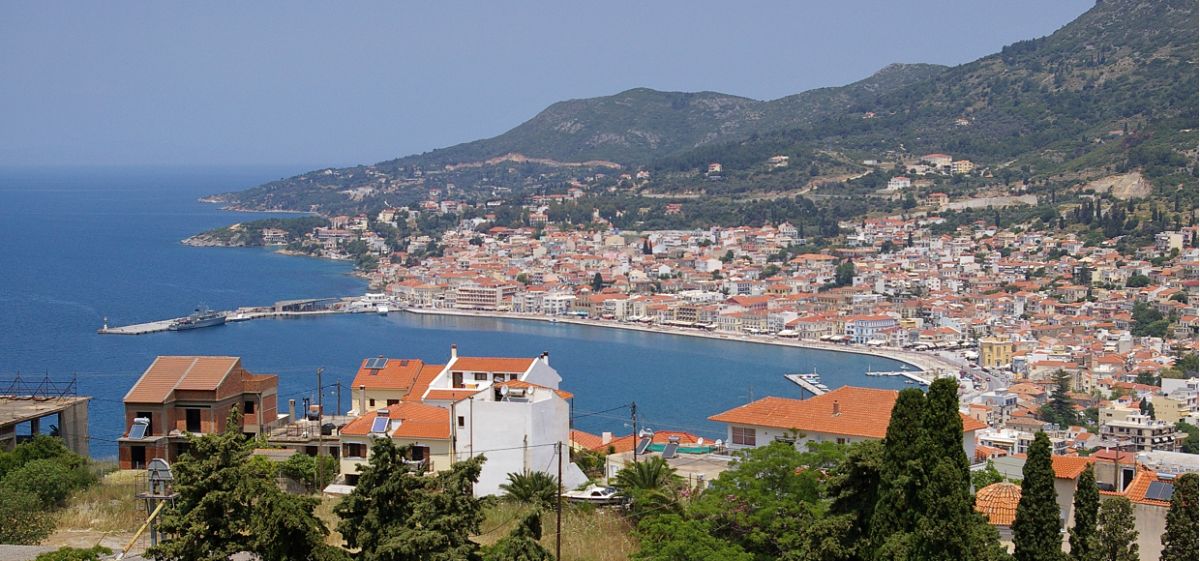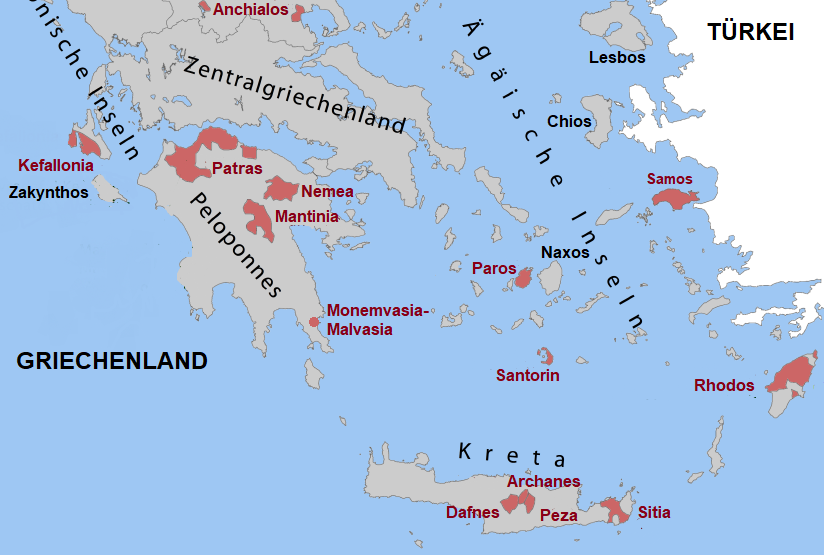Results
2,284 Results
Loading more Results ...
Loading more Results ...
Greece Aegean islands / Νησιά Αιγαίου
P.D.O. Samos (O.P.E.) / Σάμος
| P.D.O. Samos (O.P.E.) / Σάμος |
Description to P.D.O. Samos (O.P.E.) / Σάμος
The Greek island in the eastern Aegean Sea covers around 470 square kilometres and is located off the Ionian coast of Asia Minor (Anatolia, Turkey). According to legend, the Argonaut and first king of Samos, Ankaios, brought the vine to the island in 1,000 BC. The mathematician Pythagoras (580 to 496 BC), to whom the mathematical theorem named after him is attributed, the mathematician Aristarchus (~310-250 BC), who was convinced of the heliocentric system with the sun as its centre, and the philosopher Epicurus (341-270), the founder of the doctrine of the needless, wise and withdrawn enjoyment of life (Epicureanism, later Hedonism), were born here.

In the second half of the 15th century, a considerable part of the population moved to the nearby island of Chios for protection from the Ottomans. Samos became more or less deserted and most of the vineyards were destroyed. A hundred years later, the Ottoman rulers offered support to the Samosians, who were prepared to return to their homeland. The vineyards were replanted again, this time with a greater proportion of white varieties. Towards the end of the 19th century, mainly red wines from indigenous varieties were exported to Europe. Then, in 1892, phylloxera reached the island and destroyed almost all the vineyards on Samos.
Vineyards, soils and climate
Reconstruction took place mainly with the Moschato Aspro (Muscat Blanc) variety. Finally, in 1934, wine legislation defined that only white wines made from 100% Moschato Aspro may use the Samos origin. Today, this variety covers 95% of the area. The remaining 5% is made up of the two red wine varieties Ritino (Mavroudi Arachovis) and Fokiano, from which rosé wine cuvées are made. The vineyards cover around 1,800 hectares of vines on barren, calcareous soil and are often planted in terraces with only two rows.
The best locations are between 600 and 800 metres above sea level, where the vines are ventilated by the frequent Meltemi wind (the prevailing wind in summer) and the uphill rainfall also provides sufficient humidification, such as on the slopes of the Ambelos. This is named after the mythological satyr Ampelos, from whose body the first vine is said to have sprouted. There are other significant areas on the north-eastern slopes of Kerkis (1443 metres), the western mountain on Samos. The regulations on limiting yields are still relatively loose; however, quality-conscious co-operatives and winegrowers limit the yields per hectare to less than 50 hl/ha.

POP/OPE and PGE wines
There are three quality wine appellations on Samos (POP or alternatively traditional OPE). All are made from 100% pure Moschato Aspro grapes. However, there are considerable differences between the quality levels in terms of the time of harvest, spriting (alcohol fortification), ageing and maturation.
Samos Vin doux
Tsipouro grape marc spirit is added to the grape must before fermentation. The 15% alcohol content by volume is achieved almost exclusively through this addition of alcohol. The residual sugar is around 200 g/litre. The light golden, sweet wine is characterised by an aroma of oranges and spices. The Anthemis version (old name of Samos) matures for at least three years, but usually five years in oak barrels. These wines are sweeter and more powerful.
Samos Vin doux naturel
This version is made from grapes from the best sites with a low yield of 35 hl/ha. Only pre-must or must obtained with low pressing pressure is used. Fermentation is stopped early by spriting to 15% vol. The residual sugar content is around 150 g/litre. The Samos Vin doux naturel Grand Cru is made from late harvested, overripe grapes from the best vineyards. This version is aged in oak barrels for at least five years, but usually longer. The wines only reach their peak or drinking maturity after five to ten years in the bottle.
Samos Vin naturellement doux
The naturally sweet version (without sprites) is made from sun-dried grapes and is known as Nectar or Samos Nectar. These wines may bear the sub-designation Liastos, which in Greece (i.e. not exclusively for Samos) designates an unspritzed straw wine. The grapes come exclusively from the best vineyards; the overripe grapes are selectively harvested and then dried on straw mats for about a week. During slow fermentation, an alcohol content of around 14% by volume and a residual sugar content of around 360 g/l are achieved. The wine matures for at least three years in oak barrels and a further two years in the bottle. It has a golden-brown colour with often light red tones and a delicate, finely nuanced acidity structure.
Other wines and spirits
There are also two country wines classified as PGE on Samos. The white wine Samena, named after the ancient warships on Samos, is made from not quite ripe Moschato Aspro grapes, is vinified dry and reaches 12% alcohol by volume. The Golden Samena variant is also made from fully ripe grapes and is dry with a low residual sweetness. The above-mentioned rosé cuvée is made from the Fokiano and Ritino red wine varieties and is characterised by its almost orange colour. There is also a Retsina made from Muscat grapes.
Producers
The largest producer, UWC Samos (United Winemaking Agricultural Cooperative of Samos), was founded by winegrowers in 1934. It is one of the oldest winegrowers' co-operatives in Greece and is one of the 10 largest wineries. The approximately 2,200 members cultivate 1,400 hectares, which is over three quarters of the island's total vineyard area. Around 5 million litres of wine are produced every year, of which around 70% is exported. Other well-known producers are Kourtakis, Nopera Wines, Tsantali and Vakakis Wines.
Map of Greece: By Pitichinaccio - own work, CC BY 3.0, Link
edited by Norbert F. J. Tischelmayer 2/2018
Recent wines 6
 Ino S.A. - Inopraxia Viotias S.A.
— Aegean islands / Νησιά Αιγαίου
2005 P.D.O. Samos (O.P.E.) / Σάμος
Up to 10.00 €
Ino S.A. - Inopraxia Viotias S.A.
— Aegean islands / Νησιά Αιγαίου
2005 P.D.O. Samos (O.P.E.) / Σάμος
Up to 10.00 €

 Union of Winemaking Cooperatives of Samos
— Aegean islands / Νησιά Αιγαίου
2006 P.D.O. Samos (O.P.E.) / Σάμος Fillas / Φυλλας
7.95 €
Union of Winemaking Cooperatives of Samos
— Aegean islands / Νησιά Αιγαίου
2006 P.D.O. Samos (O.P.E.) / Σάμος Fillas / Φυλλας
7.95 €

 Union of Winemaking Cooperatives of Samos
— Aegean islands / Νησιά Αιγαίου
2003 P.D.O. Samos (O.P.E.) / Σάμος süß Nectar
13.80 €
Union of Winemaking Cooperatives of Samos
— Aegean islands / Νησιά Αιγαίου
2003 P.D.O. Samos (O.P.E.) / Σάμος süß Nectar
13.80 €

The most important grape varieties
More information in the magazine
- Wineflight through Thessaloniki Wine enjoyment between harbour, antiquity and concrete
- The collections and discoveries of the year Tasting season 2020/21
- In the land of the autochthones Greece
- On a quality course The Wines of Northern Greece
- Munich Wine Fair Greek wine reveals unknown specialities
- Santorini's Crater Wines Between a decline in area and a quality offensive
- From Cabernet, Stavroto, Limnio and Batiki The Wine Roads of Northern Greece
- Forest fires destroy vineyard in the Peloponnese The green hills of hope
- The "new" retsina Cult wine with cultural background
- March 2004 St. George wine